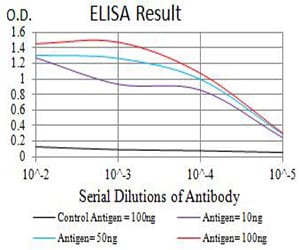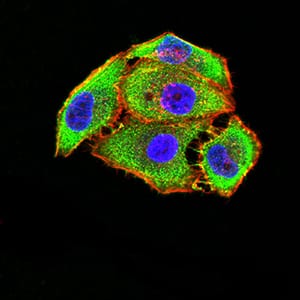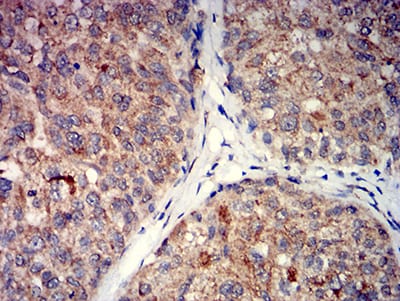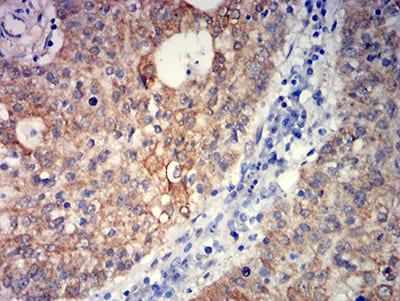



| WB | 咨询技术 | Human,Mouse,Rat |
| IF | 咨询技术 | Human,Mouse,Rat |
| IHC | 咨询技术 | Human,Mouse,Rat |
| ICC | 技术咨询 | Human,Mouse,Rat |
| FCM | 咨询技术 | Human,Mouse,Rat |
| Elisa | 咨询技术 | Human,Mouse,Rat |
| Aliases | mGlu5; GPRC1E; MGLUR5; PPP1R86 |
| Entrez GeneID | 2915 |
| clone | 1A11D10 |
| WB Predicted band size | 132.5kDa |
| Host/Isotype | Mouse IgG1 |
| Antibody Type | Primary antibody |
| Storage | Store at 4°C short term. Aliquot and store at -20°C long term. Avoid freeze/thaw cycles. |
| Species Reactivity | Human |
| Immunogen | Purified recombinant fragment of human GRM5 (AA: extra 458-580) expressed in E. Coli. |
| Formulation | Purified antibody in PBS with 0.05% sodium azide |
+ +
以下是关于S6 Ribosomal Protein (磷酸化位点Ser235/236)抗体的3篇参考文献概览:
---
1. **文献名称**:*Ribosomal protein S6 phosphorylation: from protein synthesis to cell size*
**作者**:Ruvinsky, I., Meyuhas, O. (2005)
**摘要**:该综述探讨了核糖体蛋白S6在Ser235/236等位点的磷酸化调控机制,及其通过mTOR信号通路在蛋白质翻译、细胞生长和增殖中的作用,同时提及了相关抗体的应用(如Western blot检测磷酸化状态)。
---
2. **文献名称**:*mTOR kinase inhibition and S6 phosphorylation*
**作者**:Chrestensen, C.A., et al. (2004)
**摘要**:研究通过激酶抑制剂分析S6K1对S6蛋白的磷酸化调控,验证了Ser235/236位点的磷酸化抗体在检测雷帕霉素处理后mTOR通路失活的应用,揭示了该位点在翻译起始中的功能。
---
3. **文献名称**:*S6 Kinase-independent mTOR signaling regulates cell size in vivo*
**作者**:Pende, M., et al. (2000)
**摘要**:利用基因敲除小鼠模型,证明mTOR通过S6K1非依赖途径调控S6蛋白Ser235/236磷酸化,并借助特异性抗体证实该位点磷酸化与细胞周期进程和肿瘤发生的关联。
---
**备注**:上述文献中提到的S6磷酸化抗体(如抗Ser235/236)常用于研究mTOR通路活性及细胞应激响应,实验方法涵盖免疫印迹、免疫荧光等。如需具体抗体货号或实验细节,建议补充抗体厂商信息进一步筛选。
The S6 Ribosomal Protein (Ab-235/236) antibody specifically detects phosphorylation of the S6 ribosomal protein at serine residues 235 and 236. critical sites regulated by the mTOR (mammalian target of rapamycin) signaling pathway. S6. a component of the 40S ribosomal subunit, plays a role in ribosome biogenesis and translational control. Its phosphorylation at these residues is linked to cellular growth, proliferation, and stress responses, serving as a downstream marker of mTORC1 activity.
This antibody is widely used in research to study mTOR pathway activation, particularly in contexts like cancer, metabolism, and cell cycle regulation. It helps assess signaling dynamics in response to growth factors, nutrients, or stress conditions. Applications include Western blotting, immunofluorescence, and immunohistochemistry to evaluate S6 phosphorylation status in cell lines, tissues, or in vivo models.
The phosphorylation of S6 at Ser235/236 is often associated with upregulated protein synthesis and cell growth, making this antibody a valuable tool for investigating diseases involving dysregulated mTOR signaling, such as tumors, diabetes, or neurodegenerative disorders. Proper experimental controls (e.g., rapamycin treatment to inhibit phosphorylation) are recommended to confirm specificity.
×